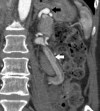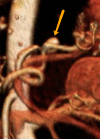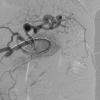Coil Embolization of Spontaneous Splenic Arteriovenous Fistula for Treatment of Portal Hypertension
- PMID: 28396581
- PMCID: PMC5395133
- DOI: 10.12659/ajcr.901845
Coil Embolization of Spontaneous Splenic Arteriovenous Fistula for Treatment of Portal Hypertension
Abstract
BACKGROUND Splenic arteriovenous fistula (AVF) is a rare cause of portal hypertension which may manifest with abdominal pain, diarrhea, ascites, and/or hematemesis. Fistula formation may be traumatic or spontaneous. Eighty-six percent of spontaneous splenic AVFs occur in women, and 55% are associated with a preexisting splenic artery aneurysm. CASE REPORT A 64-year-old Caucasian female with unremarkable past medical history presented with new onset of left lower quadrant abdominal pain and persistent diarrhea. CTA demonstrated dilated mesenteric veins consistent with portal hypertension. A 1-cm splenic artery aneurysm associated with a splenic AVF was identified and confirmed by celiac angiography. The splenic artery was embolized both distal and proximal to and within the aneurysm sac. Completion arteriography showed minimal flow throughout the splenic artery, and there was no flow into the splenic AVF. CONCLUSIONS Traditionally, splenectomy has been the definitive treatment, but coil embolization has been recently reported. Successful coil embolization of a splenic AVF is described. Physicians should be aware of this pathology as an etiology of portal hypertension.
Conflict of interest statement
Figures
References
-
- Brothers TE, Stanley JC, Zelenock GB. Splenic arteriovenous fistula. Int Surg. 1995;80:189–94. - PubMed
-
- Stener B. Arterio-venous shunt in the spleen diagnosed before operation. Case report. Acta Chir Scand. 1955;108(5):344–50. - PubMed
-
- Goodhart JF. Arterio-venous aneurysm of splenic vessels, with thrombosis of mesenteric veins and localised acute colitis. Tr Path Soc London. 1889;40:67–70.
-
- Madoff DC, Denys A, Wallace MJ, et al. Splenic arterial interventions: Anatomy, indications, technical considerations, and potential complications. Radiographics. 2005;25:191–211. - PubMed
-
- Campbell D, Geraghty JG, McNicholas MM, Murphy JJ. Delayed presentation of traumatic splenic arterio-venous fistula. Ir Med J. 1991;84(4):129–30. - PubMed
Publication types
MeSH terms
LinkOut - more resources
Full Text Sources
Medical
Miscellaneous




